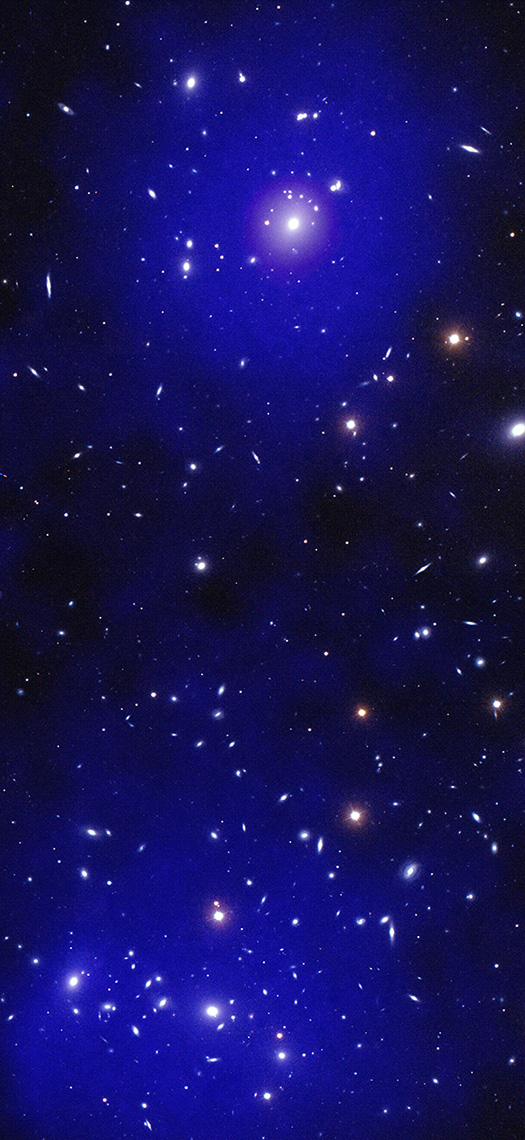NASA's Chandra Finds Galaxy Cluster Collision on a "WHIM"
This image features Abell 98, a system of galaxy clusters that includes a pair in the early stages of a collision. Astronomers have used data from NASA’s Chandra X-ray Observatory (shown as blue and purple with optical data from the WIYN telescope on Kitt Peak in Arizona appearing white and red) to identify key structures and look for “missing” matter in the Universe.
This missing material is not dark matter, which is invisible, of an unknown nature, and thought to constitute most of the matter in the universe, but “normal” matter found in familiar objects like stars, planets, and humans. About a third of this matter that was created in the first billion years or so after the Big Bang has yet to be detected by observations of the local universe, that is, in regions less than a few billion light-years from Earth.
Scientists have proposed that at least some of this unaccounted-for mass could be hidden in gigantic strands, or filaments, of warm to hot (temperatures of 10,000 to 10 million Kelvin) gas in the space in between galaxies and clusters of galaxies. They have dubbed this the “warm-hot intergalactic medium,” or WHIM.
A team of astronomers examined Chandra data of Abell 98, which is about 1.4 billion light-years from Earth, and said they have likely found evidence of this WHIM residing in the space between the two galaxy clusters. The Chandra data reveal a bridge of X-ray emission (shown in a labeled version) between two of the colliding clusters containing gas at a temperature of about 20 million Kelvin and relatively cooler gas with a temperature of about 10 million Kelvin. The hotter gas in the bridge is likely from gas in the two clusters overlapping with each other. The temperature and density of the cooler gas agree with predictions for the hottest and densest gas in the WHIM.
In addition, the Chandra data show the presence of a shock wave, which is similar to a sonic boom from a supersonic plane. The location of the shock wave is labeled and is identified by sudden decreases in the brightness of the X-rays and the gas temperature, measured from the northern to southern side of the shock. This shock wave is driven by and located ahead of one of the galaxy clusters as it is starting to collide with another cluster. This would be the first time that astronomers have found such a shock wave in the early stages of a galaxy cluster collision, before the centers of the cluster pass by one another. This shock wave may be directly connected to the discovery of the WHIM in Abell 98 because it has heated the gas in between the clusters as they collide. This may have raised the temperature of the gas in the WHIM filament — estimated to contain some 400 billion times the mass of the Sun — high enough to be detected with Chandra data.
A paper describing this result by Arnab Sarkar et al was published in The Astrophysical Journal Letters and is available at https://arxiv.org/abs/2208.03401. Other authors on the paper include Scott Randall (Center for Astrophysics | Harvard & Smithsonian), Yuanyuan Su (University of Kentucky), Gabriella E. Alvarez (CfA), Craig Sarazin (University of Virginia, Charlottesville, Virginia), Paul Nulsen (CfA), Elizabeth Blanton (Boston University, Boston, Massachusetts), William Forman (CfA), Christine Jones (CfA), Esra Bulbul (Max Planck Institute for Extraterrestrial Physics, Garching, Germany), John Zuhone (CfA), Felipe Andrade-Santos (CfA), Ryan Johnson (Gettysburg College, Gettysburg, Pennsylvania), and Priyanka Chakraborty (CfA).
Additional evidence for the WHIM filament between these two clusters was found with the Japan Aerospace Exploration Agency’s Suzaku, in a new paper led by Gabriella Alvarez, also of CfA. Their paper also gives evidence for the WHIM on the opposite side of the cluster that is leading the collision. (The general location and direction of this Suzaku-detected filament is labeled, but the filament itself is not visible in the Chandra data, despite the field of view extending further to the north than shown here.) These two detections of the WHIM indicate that the clusters are located along a colossal structure that is 13 million light-years long. The paper by Alvarez was recently accepted for publication in The Astrophysical Journal and is available at https://arxiv.org/abs/2206.08430.
NASA's Marshall Space Flight Center manages the Chandra program. The Smithsonian Astrophysical Observatory's Chandra X-ray Center controls science operations from Cambridge, Massachusetts, and flight operations from Burlington, Massachusetts.


